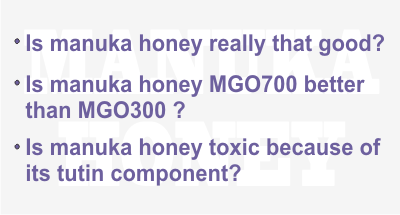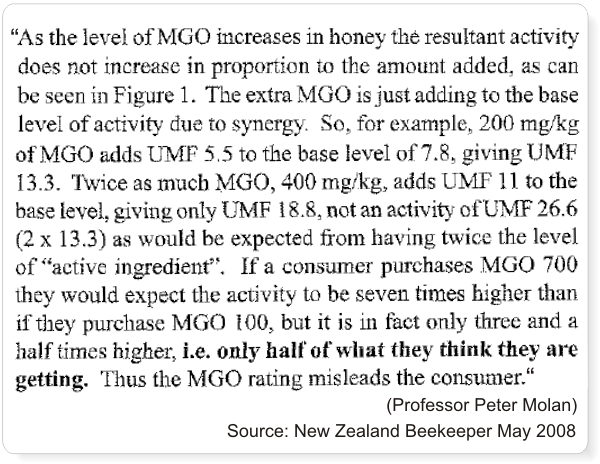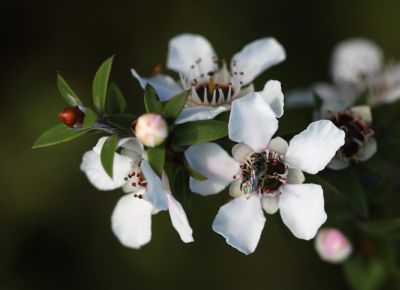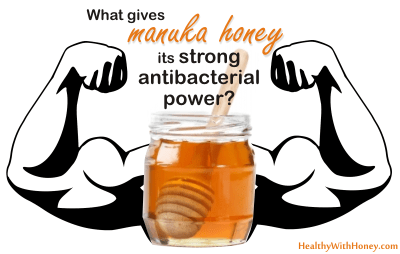Manuka honey is the most wanted honey these days. Is it that good? What MGO is better? How about the cases of poisoning with manuka honey? This article talks about all of these.
Is manuka honey really that good or only marketing for another money-bringing industry? Is people buying less manuka honey? Not by far! New Zealand’s honey exports have grown from $NZ81 million in 2008–09 to $NZ187 million in 2013–14.
So why the need for a sumptuous celebration?
Because there is a need of raising the confidence and trust of consumers. You’ll see why.
In 2016 manuka honey will be ten years old. Of scientific recognition, of course! MGO is unveiled. 2016 is going to be the anniversary year for all manuka honey lovers and it will be celebrated by Manuka Health New Zealand. There will be conferences, press releases, tons of online articles. Each and every green-bio-blogger will post the news. Another boom for manuka honey. Another reminder of how good and incredible is, and how it can save you where allopathic medicine fails.
How come there are only 10 years?
10 years is so little… Why would we say manuka honey is 10 years old? It’s hilarious. Well, they don’t say that. They say there had been 10 years since the discover of the high content of methylglyoxal in manuka honey.
It was actually not Henle’s merit, but one of his students, who discovered, by chance, the high level of MGO in manuka honey. What is not mentioned is that Henle’s acclaim as a scientist is as a food chemist specializing in the area of harmuful substances formed when food are spoiled by heating. In the end, it doesn’t really matter much who discovered it and how, the fact that we now know that, help us in understanding more the amazing benefits of manuka honey.
But we still need to keep in mind that manuka honey is known for thousands of years and that there were many other researchers who brought important contribution to everything we know today about this honey, way before 2006.
Who is Thomas Henle?
In 2006 professor Thomas Henle’s team at the Technical University of Dresden, Germany, was the first who discovered methylglyoxal in manuka honey and assert that it could be used to differentiate it from other types of honey.

Picture source http://www.manukahealth.co.nz/
With this occasion, Manuka Health is preparing to celebrate 10 years of manuka honey science next year. It will be an invitation-only event, which will be held in February 2016, in Auckland, New Zealand. As one of the most important invited VIPs, Professor Henle will share details about his most recent work with manuka honey and its specific properties. He will also describe the groundbreaking research that uncovered the mystery of manuka honey.
Manuka Health Chief Executive Kerry Paul says:
“We are looking forward to celebrating this important milestone. The discovery of methylglyoxal in manuka honey was a game-changer for the New Zealand manuka honey industry. The research meant honey producers could identify and grade their manuka honey based on a credible, scientifically based system.”
“We are grateful and excited that Professor Henle has agreed to take time out of his busy schedule to join us, and to share some of his impressive knowledge on the science behind manuka honey. He is a master in his field and I’m sure everyone that attends will learn things about manuka honey that they didn’t know beforehand.”
2016 will mark 10 Years of Manuka Honey Science
Who was Peter Molan?
The bad news of this year was that Peter Molan, the man who uncovered the power of manuka honey, died at home on September 16, aged 71. He was researching manuka honey since 1981 and was the one who “revolutionised the New Zealand honey industry”, as it was said by the 2001 citation for his NZ Science and Technology silver medal.
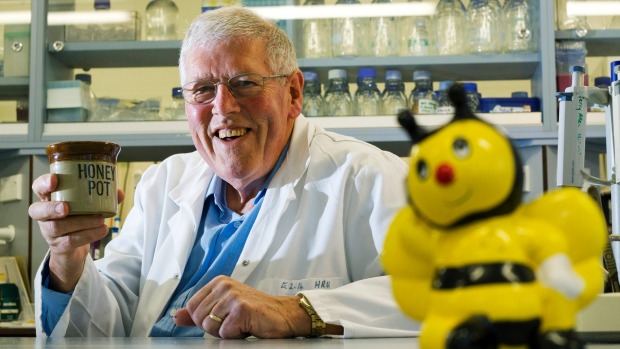
Picture source http://www.stuff.co.nz/
Molan started looking into manuka honey in 1981. Which is more than 10 years ago.
The funny thing is that he didn’t like the manuka taste. After winning a KuDos lifetime achievement award in 2013 Molan recognized this: “The only time I ever eat it is if I’ve got a sore stomach.”
Peter Molan created UMF.
Peter Molan was the one who created the Unique Manuka Factor (UMF) rating for honey, and later set up the Molan Gold Standard. The citation for his 1995 MBE said his work was the “single most important factor” in changing the perceived value of manuka honey.
Basically, Peter Molan was the one who started the whole manuka honey industry. But behind being a scientists, he was an incredible good man. He answered all phones and emails received, helping people all over the world. His wife Alyson said he “took risks to stand up for what he believed”.
Alyson was married to Peter for 24 years and initially thought his obsession with manuka honey would pass. But it wasn’t like that. It became his work, this passion and his hobby. One day, his wife spilled boiling water over her hand. Alyson says “He just bunged honey all over it, wrapped it up. And the bit that he missed wrapping, it had a huge blister. The rest of my hand was absolutely clear.”
This is probably how the manuka gel was invented, and was later used for everything from teenagers’ pimples to nappy rash.
Manuka honey – THE BEST to treat wounds, burns, skin infections.
What’s all the fuss with manuka honey and its MGO?
Well, for a start, it kills microorganisms which have become resistant to our synthetic drugs. You can find lots of studies already published, especially online. We need to make a difference here between manuka honey consumed internally and the one consumed externally. While externally manuka proved to be extremely helpful and there are plenty clinical trials which prove it, internally there are two different opinions: one claiming that MGO, while ingested with honey does not do any harm to the body, and one affirming that such a large quantity of MGO is connected to AGEs ( may contribute to aging, diabetes, and other disorders). For a better understanding, this article can be of help: Methylglyoxal Comes of AGE.
Manuka honey has proven qualities on any type of external condition. See: Manuka honey – THE BEST to treat wounds, burns, skin infections. Which is why medical honey has been created. and all the already made dressings for skin diseases. See:
– Medihoney dressings – the best wound care dressing products;
– Xtrasorb – the best in the list of wound care dressings. Product review;
– Medihoney wound dressing review
It showed very good results in killing germs like MSSA (Methicillin Susceptible Staphylococcus Aureus); MRSA (Methicillin Resistant Staphylococcus Aureus); Pseudomonas Aeruginosa; Helicobacter pylori; Streptococcus pyogenes, Escherichia coli, Clostridium difficile.
See Is manuka honey a natural treatment for MRSA? Is it the best?
Be careful: if you are diabetic, do not eat manuka honey. See the article Methylglyoxal induces advanced glycation end product (AGEs) formation and dysfunction of PDGF receptor-beta: implications for diabetic atherosclerosis. for scientific details. And google for others, there are plenty.
Is MGO the antimicrobial factor of manuka honey?
Some say NO.
There are scientists who say the MGO content of manuka honey is not responsible for its antimicrobial activity. Studies have proved that after neutralization of this compound, manuka honey still retains bactericidal activity. But so does all the other types of honey, and some of them are even considered today to be at least as good as manuka honey: maharishi honey, tualang honey, gelam honey, medihoney to name only a few.
Methylglyoxal does not appear to be the main contributor to the antimicrobial and antibacterial activities. (Molan, P. (2008). “An explanation of why the MGO level in manuka honey does not show the antibacterial activity”. New Zealand BeeKeeper.) In this article Peter Molan says “MGO scale does not show the non-peroxide antibacterial activity” and suggests that “consumers are being misled by it being claimed that displaying the level of the active antibacterial component of manuka honey shows them the antibacterial activity of the honey”.
Yet, the manuka honey industry has lots of gradings for manuka honey, and all of them are showing the content of MGO (MGO, UMF, K, A). See here how to differentiate between manuka honey grading MGO, UMF, Active.
What all researchers agree with is that honey has a complex composition with elements yet not discovered.
The article Peter Molan published in 2008 is still available on researchcommons.waikato.ac.nz.
Or you can download it from here: MGO is not responsible for the antimicrobial activity of manuka honey.
Antimicrobial activity = 0.0275 times MGO plus 7.826
This means that besides the MGO activity there is another antimicrobial activity equivalent to 7.8% phenol.
As the level of MGO increases in honey the resultant activity does not increase in proportion to the amount added. See here an excerpt from the article “An explanation of why the MGO level in manuka honey does not show the antibacterial activity” by Professor Peter Molan, published in 2008, in New Zealand Beekeeper.
Manuka honey MGO700 is not better than manuka honey MGO300
Does this mean MGO is not important? It means that when we buy manuka honey, UMF is more relevant.
Manuka honey of MGO700 is equivalent to 8-9% phenol.
Manuka honey UMF 10 is the equivalent of 10% phenol.
Why is the antimicrobial activity compared to phenol?
First, it needed to be compared to something, so we can understand the power of this activity. As Molan says, before Britain joined UE, there were regulations that required all disinfectants sold to have their activity rated against phenol. This is why phenol was chosen as a standard to relate to.
Manuka honey of MGO700 is equivalent to 8-9% phenol.
Manuka honey UMF 10 is the equivalent of 10% phenol.
How come MGO is toxic, but in manuka honey is antimicrobial?
If we look in wikipedia we will not see methylglyoxal as a recognized antibacterial substance. Nobody reports it as being used as an antibacterial agent.
In fact, methylglyoxal may contribute to aging, diabetes, and other disorders. (Methylglyoxal Comes of AGE, by Ravichandran Ramasamy, published in 2006) Disorders called AGE = advanced glycation end products.
According to this article “Many factors contribute to the accumulation of methylglyoxal, including hyperglycemia, uremia, oxidative stress, aging, and inflammation. Methylglyoxal can react with and modify both proteins and DNA, leading to the generation of advanced glycation end products (AGEs). The modification of targets by methylglyoxal and its derivatives contributes to upregulation of inflammatory and tissue-injury-provoking molecules (at least in part through the interaction of AGEs with their receptor RAGE), gene transcription, protein crosslinking, and apoptosis.”
We also ingest methylglyoxal from food and environment. Some products contain MGO (like the smoke inhaled while smoking), others produce it after had been heated. Regular honey also raises its level of MGO after heating. So shelf honey contains a higher level of MGO, than it had in the hive.
In manuka honey, MGO acts differently.
Because of synergy.
The synergy between all honey’s compounds turn MGO from a toxic substance into an antibacterial substance. There is something in manuka honey, without any antibacterial activity of its own, that acts as a synergist with the MGO to create an effect even greater than that predicted by knowing only the separate effect of MGO.
Warning: Manuka honey may contain a highly toxic substance!
It’s called tutin.
Tutin is a neurotoxic compound produced by the shrub Coriaria arborea (tutu) native to New Zealand. A vine hopper insect (Scolypopa australis) feeds on the sap of tutu plants and excretes honeydew that contains the toxin tutin.
This honeydew can be collected by bees for honey production. Tutin is highly toxic to humans even in extremely small amounts. High levels of tutin in honey can cause severe effects, including death.
The highest risk areas for honey contaminated with tutin are above latitude 42 degrees south. Northern Hawkes Bay, Bay of Plenty and Coromandel. Poisonings have also been reported in the Marlborough Sounds and Northland.
72% of the volume of honey harvested in New Zealand comes from high risk areas.
Seasonal risk is highest for harvest dates between 1 January and 30 June each year.
Would all these data showing how big the risk is. Yes.
The highest number of persons poisoned with honey with tutin was in 2008 in Coromandel. 22 persons had a medium to high poisoning.
How dangerous is it?
Signs and symptoms of tutin poisoning generally last about 48 hours and include nausea, vomiting, giddiness, headaches, abdominal pain, convulsions, rigidity of limbs, and unconsciousness. Some symptoms last for up to 6 weeks including memory loss, anxiety, pins and needles in fingers and toes, a heavy stiff numb feeling and death. (Goodwin, Mark (2013) A New Zealand History of Toxic Honey Page 155)
Levels of tutin of between 30 and 50 milligrams per kilogram were found in the leftovers of the honey consumed by the poisoned victims.
What is the safe level of admitted tutin?
Lots of research has been done since the 2008 incident. The conclusion is that it is possible to get adverse effects following the consumption of honey containing tutin at the current maximum level of 2 mg/kg. Which was the accepted level till March 2015, but which changed (due to lots of research) to 0.7 mg/kg. This regulation is given by the Ministry for Primary Industries of New Zealand, which inserted it in food safety regulations, requiring honey to be tested for Tutin. This came into effect in New Zealand law on 12 March 2015.
Adverse effects are more likely of 0.9 g of honey per kg of body weight (as per high consumers) or greater is eaten in one sitting. For a high consuming adult, this equates to consuming approximately 3 tablespoons of honey (standard New Zealand tablespoon is 15 mL) containing tutin at the old level of 2 mg/kg in one sitting (and which is probably the level found in the jars we find on the market right now.)
Survey data indicates that New Zealand children 5 to 8 years of age may be exposed to higher levels of tutin per kg of body weight than adults.
Why don’t we know much about this tutin in manuka honey?
If all the importers of manuka honey would ask for tests, it would mean a probable high net cost of $NZ187 million of export revenue at risk. That’s why. New Zealand exports honey to the United Kingdom, China, Hong Kong, the European Union and Singapore.
A significant proportion of honey that is packed in New Zealand, whether it is sold on the domestic market or exported, is packed under risk management programmes (RMPs) under the Animal Products Act. Honey not packed under an RMP is usually packed by small producers solely for the domestic market.

